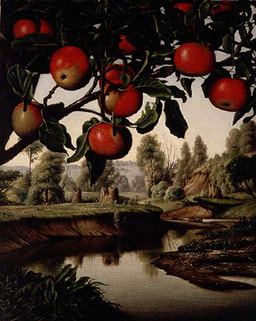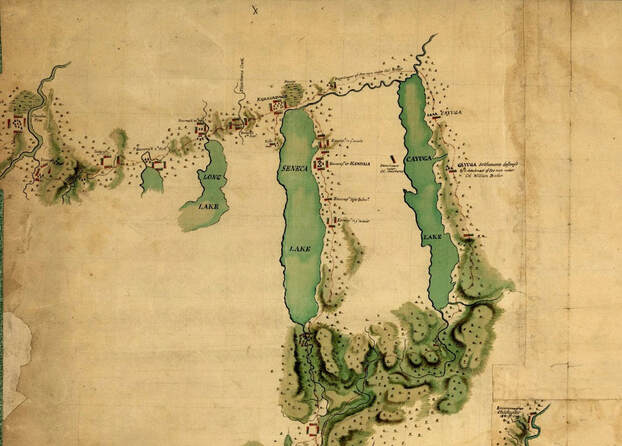 Apple Trees by Levi Wells Prentice circa 1890 Source: Wikimedia Apple Trees by Levi Wells Prentice circa 1890 Source: Wikimedia Drive through any rural area of the U.S. and you will inevitably find apple orchards; some may be new, others may be reminders of a family homestead long abandoned. But the trees remain. It's believed that the Pilgrims brought apple seeds with them to the American colonies when they arrived in the early 1600s and grafted the European variety with the native American species of crab apple. Over the years farmers created many new varieties of apples. But not for eating. Apple trees and orchards had other economic uses. One of the first things a settler would do is plant an apple orchard as a way to stake claim to a parcel of land. When investors formed the Ohio Company to lure colonists from the eastern states further West, they insisted the settlers plant at least fifty apple trees to establish their claim. Apples provided an important part of the American diet: cider. Most colonists used their apples to make cider, which was safer to drink than water. Indeed, one of out of every ten farms in New England operated a cider mill. Estimates are that an average New England family consumed about 35 gallons per person per year. (The author, Tracy Chevalier, wrote a historical novel centered around a family in Ohio that grows cider apples titled At the Edge of the Orchard. Although dark, it includes a fascinating botanical history.) By the mid 1700s, orchards were an integral part of the American landscape. And although it may be assumed that the European settlers were the only ones to plant orchards, there was ample evidence that Native Americans also incorporated orchards into their lifestyle. In 1779, a scout for the Revolutionary Army drew a map of the Cayuga and Seneca native American settlements in the Finger Lakes region of New York. As the map shows, there were numerous orchards dotting the landscape. General Sullivan, ordered his soldiers to go into the villages and wipe out the crops in retribution for an Haudenosaunee (Iroquois) incursion against the army. One soldier wrote in his diary about an attack on a village in what is now Geneva NY: we found about 80 houses something large some of them built with hew and timber and part with round timber and part with bark. Large quantities of corn and beans with all sorts of sauce, at this place a fine Young Orchard, which was soon all girdled. Apple production eventually industrialized and large scale apple orchards and mills started popping up in rural areas. By then apple consumption had expanded as well. Apples were used to make vinegar, for baking, and feed for livestock. Cider production was still popular but German immigrants introduced beer in the early part of the 19th century and the appetite for cider waned. Whether beer production and Prohibition in the 1920s played a role is not entirely known, but for whatever the reasons, apple growers began to plant less varieties of apples for cider and rely on trees that produced larger, sweeter fruit for the markets.
Hard cider has had a resurgence on a large commercial scale. There are now numerous varieties of hard cider in the grocery stores alongside beer. And apple orchards are now eco-tourism destinations. Fans of hard cider can bring their kids to an orchard to pick eating and baking apples and then sidle up to a bar to consume the hard cider. It's still a family affair. Sources: American Canopy. Trees Forests, and the Making of a Nation. Eric Rutkow. Scribner. 2012 Apples on the Border: Orchards and the Contest for the Great Lakes. William Kerrigan. Michigan Historical Review Vol. 34, No. 1, Emerging Borderlands (Spring, 2008), pp. 25-41 (17 pages) Internet archive: Full Text of Sullivan's Expedition Against the Indians of New York.
0 Comments
Leave a Reply. |
AuthorSheila Myers is an award winning author and Professor at a small college in Upstate NY. She enjoys writing, swimming in lakes, and walking in nature. Not always in that order. Archives
April 2024
CategoriesAll Adirondacks Algonquin Appalachia Award Cades Cove Canada Chestnut Trees Christmas Civilian Conservation Corps Collis P. Huntington Creativity Doc Durant Durant Family Saga Emma Bell Miles Finger Lakes Great Depression Hell On Wheels Historical Fiction History Horace Kephart Imagination National Parks Nature Publishing Review Screenplay Short Story Smoky Mountains Snow Storm Stone Canoe Literary Magazine Thomas Durant Timber Wilderness World War II Writing |
|
|
All materials Copyright 2022
Any reproduction, reprint or publication without written consent of author prohibited. |

 RSS Feed
RSS Feed